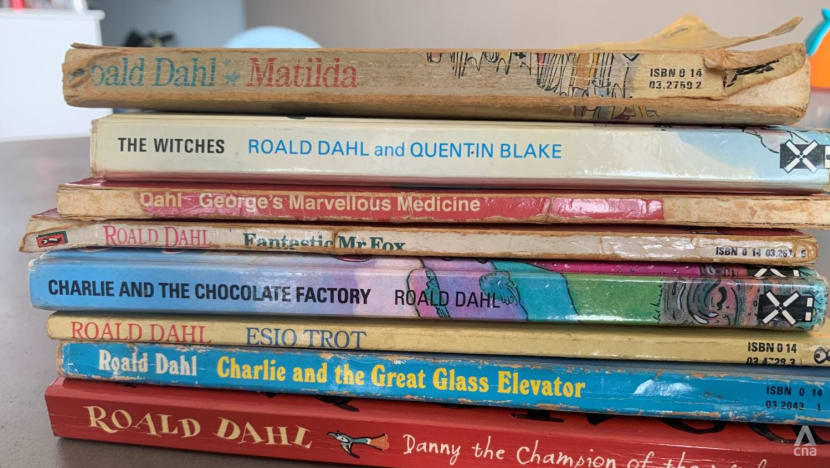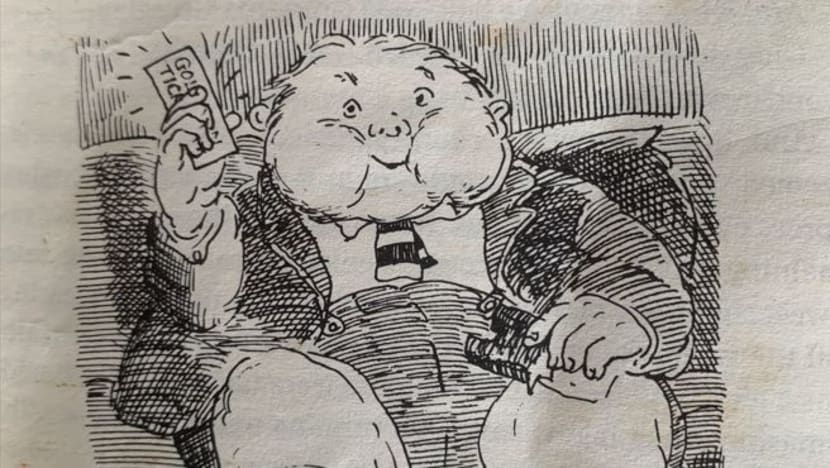Commentary: Leave my beloved Roald Dahl books alone
Childhood favourites like Matilda and Charlie And The Chocolate Factory have been scrubbed of some of author Roald Dahl's colourful language for a modern audience. CNA's Charlene Tan wonders what the fuss is all about.

The author's decades-old copies of Roald Dahl books. (Photo: CNA/Charlene Tan)
SINGAPORE: The pages of my decades-old copies of Charlie And The Chocolate Factory and Matilda are yellowed, spotted; the spines cracked and peeling - a testament to how much I have read and re-read them. But my beloved Roald Dahl books have become the latest victims of some “woke” crowd, or so I’m told.
With the headline Roald Dahl Goes PC (politically correct) In A World Where No One Is “Fat” And The Oompa-Loompas Are Gender Neutral, British newspaper The Daily Telegraph sparked furore when it reported that new editions of these children’s classics contained hundreds of changes, particularly in references to weight, mental health, gender and race.
Author Salman Rushdie slammed the changes as “absurd censorship”. Even United Kingdom Prime Minister Rishi Sunak waded into the fray to say that literature should be “preserved and not airbrushed”.
On its part, the publisher Puffin said the review was done to ensure the British author’s works “can continue to be enjoyed by all today”.
As someone who has always known I wanted to pass these books on to my children (even before I knew I wanted children), I went to see what the fuss was all about.
Related:
WHAT DOES “AIRBRUSHING” ACHIEVE?
Since I'm not able to rush out to a British bookstore, I looked for changes flagged in various news stories and found myself almost immediately puzzled by how the new language was considered more acceptable or less insensitive.
Here’s one: Augustus Gloop, a nine-year-old allowed to visit Willy Wonka’s chocolate factory alongside Charlie, is now “enormous”, not “enormously fat”. The next line reads “Great folds bulged out from every part of his body, and his face was like a ball of dough”, scrubbing out the more colourful “Great flabby folds of fat” and “monstrous ball of dough”.
Colourful descriptions or not, readers will picture Augustus Gloop as a fat child. Barely two lines later, eating is said to be his hobby and all he is interested in. In my copy, there’s an illustration to leave nothing to the imagination.

One could argue that nothing was lost in this edit. So what does scrubbing out the term “fat” really achieve here, when he is still called a “pig” and “great big greedy nincompoop”? Does it dull insults or reduce the risk of body image issues? Or have those descriptors been scrubbed out too?
And then there are the references to women. The Daily Telegraph points out that Fantastic Mr Fox’s sons have become daughters, Mrs Twit’s “fearful ugliness” is no longer fearful, while Mrs Hoppy in Esio Trot is a “kind”, not “attractive” middle-aged lady.
The Witches opens with a helpful note explaining that real witches look very much like ordinary women and work in ordinary jobs, like “working as a cashier in a supermarket or typing letters for a businessman or driving around in a fancy car”.
Perhaps the publisher believes my children will feel more empowered if witches with murderous thoughts took on ordinary jobs like “top scientist or running a business” instead. I think I’d prefer companies that hire and treat employees equitably and society not impose outdated expectations and judgments on women.
ROALD DAHL STORIES ARE NASTY BY NATURE
Sanitising specific issues like weight and gender seems disproportionate when we stop and consider just how loony and problematic - some say nasty - Roald Dahl stories can be.
The beloved Matilda has a sadistic school headmistress who swings children over the gate by their pigtails and punishes children in the Chokey, reminiscent of a medieval iron maiden. Whose classic childhood fun didn’t include a homemade torture device?
George’s Marvellous Medicine follows a boy feeding his nasty grandmother a fantastical concoction of items around his home such as deodorant, animal medicines and engine oil “to shake the old woman up a bit”. Esio Trot is a heartwarming story of a lonely old man who steals a tortoise to gaslight his way into his neighbour’s heart.
Yes, children’s books can shape the minds of young readers. Dahl recognised that and updated some writing himself. Dahl revised the Oompa-Loompas in 1973 as fantastical creatures from the made-up Loompaland, from their original depiction as African pygmies when first published in 1964.
CONTENT LABELS CAN PROVIDE CONTEXT
But surely, shoehorning our current social values and norms into works published decades ago, especially long after the authors have died, isn’t the way to go. There would be no end to the changes as society evolves and every chance the situation would devolve into constant bickering over specific words and portrayals.
When does it cease to be a Roald Dahl book? How do we preserve what we love about such classic books, yet ensure young, impressionable minds don’t go away with the wrong lessons?
Here’s what this parent thinks could be useful: Use content labels or advisories, in the same spirit of those carried in film and TV shows, that alert potential readers to problematic language or upsetting content.
Parents and teachers can have more information to decide on appropriate literature or find ways to help children understand and process the material. Inform the reader and help children navigate history and literature, not take that decision out of our hands.
Readers could also be reminded more prominently when the work was first published. Authors and their works are reflections of their time and experience.
“Words matter”, Puffin wrote in a notice for the revised works. Context matters too.
DISCOVER BETTER STORIES
What seems notable is that it wasn’t an outcry from disgruntled readers that led to this language purge. But if society reaches a point where Roald Dahl books are deemed incompatible with its time and values, I agree with His Dark Materials author Philip Pullman who said: “Let them fade away - read better writers.”
Enid Blyton books were a childhood staple of mine that have not aged well. It’s hard to read past the racism and sexism going back to them as an adult. So what I’ll do is look for other books, better books to introduce to my children - books that have empowerment and self-agency built into them, not merely papered over by a publisher.
For now, I will stow away my non-PC Roald Dahl copies until my kids are old enough to step into the fantastic and nasty world of Willy Wonka, The Twits, The BFG and Mr Fox. But I don’t assume they will take to Roald Dahl in the same way as I did.
There are and will be better stories out there for them and I hope to discover those with them soon.
Charlene Tan is an editor at CNA Digital where she oversees commentaries.

















